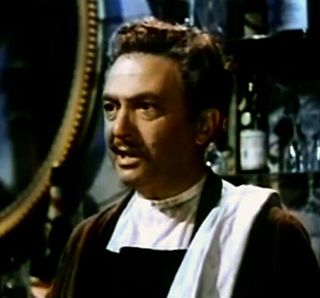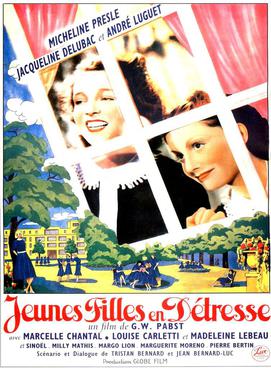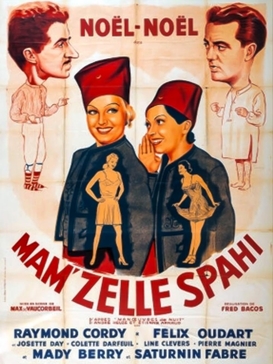
Georg Wilhelm Pabst was an Austrian film director and screenwriter. He started as an actor and theater director, before becoming one of the most influential German-language filmmakers during the Weimar Republic.

Léonie Marie Julie Bathiat, known professionally as Arletty, was a French actress, singer, and fashion model. As an actress she is particularly known for classics directed by Marcel Carné, including Hotel du Nord (1938), Le jour se lève (1939) and Children of Paradise (1945). She was found guilty of treason for an affair with a German officer during World War II.

Viviane Romance was a French actress.

Marcel Dalio was a French movie actor. He had major roles in two films directed by Jean Renoir, La Grande Illusion (1937) and The Rules of the Game (1939).

Ginette Leclerc was a French film actress. She appeared in nearly 90 films between 1932 and 1978. Her last TV appearance was in 1981. She was born in Ile-de-France, France and died in Paris. She was married to the actor Lucien Gallas. She is possibly best-remembered for her roles in such films as Le Corbeau (1943), The Baker's Wife (1938), Cab Number 13 (1948), and Tropic of Cancer (1970).

Girls in Distress is a 1939 French drama film directed by G. W. Pabst and starring Marcelle Chantal, Micheline Presle and André Lugue.

Rasputin is a 1938 French historical film directed by Marcel L'Herbier and starring Harry Baur, Marcelle Chantal and Pierre Richard-Willm. It depicts the rise and fall of the Russian mystic Grigori Yefimovich Rasputin, the advisor to the Romanov royal family. It was shot at the Joinville Studios in Paris. The film's sets were designed by the art director Guy de Gastyne.

Ciboulette is a 1933 French musical film directed by Claude Autant-Lara and starring Simone Berriau, Robert Burnier and Armand Dranem. It is an adaptation of the 1923 operetta of the same name. The film's art direction was by Lazare Meerson and Alexandre Trauner. It was part of a popular cycle of operetta films during the decade.

Dark Eyes is a 1935 French drama film directed by Viktor Tourjansky and starring Harry Baur, Simone Simon and Jean-Pierre Aumont. The film's sets were designed by the art director Eugène Lourié.

Return to Paradise is a 1935 French film directed by Serge de Poligny and starring Claude Dauphin, Mary Morgan and Marcel André. The film's sets were designed by Pierre Schild.
Louise Pauline Mainguené, known as Sylvie, was a French actress.
Marc Sorkin or Mark Sorkin (1902–1986) was a Russian-born film editor and director. He worked with Georg Wilhelm Pabst on a number of films as editor or assistant director.

Women's Prison or Women's Prisons is a 1938 French drama film directed by Roger Richebé and starring Viviane Romance, Renée Saint-Cyr and Marguerite Deval. Based on the 1930 novel of the same title by Francis Carco, it was remade twice as the 1947 Swedish film Two Women and the 1958 French film Women's Prison.

Dark Sunday is a 1948 French drama film directed by Jacqueline Audry and starring Michèle Alfa, Paul Bernard and Marcelle Derrien. The film takes its name from the French title of the song "Gloomy Sunday".

Angelica is a 1939 French-Italian adventure film directed by Jean Choux and starring Viviane Romance, Georges Flamant and Guillaume de Sax. It is based on a novel by Pierre Benoît.

The Kiss of Fire is a 1937 French romantic comedy film directed by Augusto Genina and starring Tino Rossi, Michel Simon, Mireille Balin and Viviane Romance. The film is based on the 1924 novel Naples au baiser de feu by Auguste Bailly. It had previously been made as a 1925 silent film and was later adapted again for a remake Napoli terra d'amore in 1954.

Maya is a 1949 French drama film directed by Raymond Bernard and starring Viviane Romance, Marcel Dalio and Jean-Pierre Grenier. It is based on a 1924 play of the same title by Simon Gantillon. It was shot at the Studio François I in Paris. The film's sets were designed by the art director Léon Barsacq.

Mam'zelle Spahi is a 1934 French comedy film directed by Max de Vaucorbeil and starring Noël-Noël, Raymond Cordy and Josette Day. It was produced and distributed by the French subsidiary of Fox Film. It was shot at the Joinville Studios of Pathé-Natan in Paris.

Midnight Tradition is a 1939 French mystery thriller film directed by Roger Richebé and starring Viviane Romance, Georges Flamant and Marcel Dalio. It is based on the 1930 novel of the same title by Pierre Mac Orlan. It was shot at the Neuilly Studios in Paris. The film's sets were designed by the art directors René Renoux and Roland Quignon.

Marthe Richard is a 1937 French war spy film directed by Raymond Bernard and starring Edwige Feuillère, Erich von Stroheim and Marcel Dalio. It was shot at the Joinville Studios in Paris. The film's sets were designed by the art director Jean Perrier. It is based on the story of the French First World War spy Marthe Richard. It enjoyed great commercial success in France and was one of the most popular spy films of the decade.


















